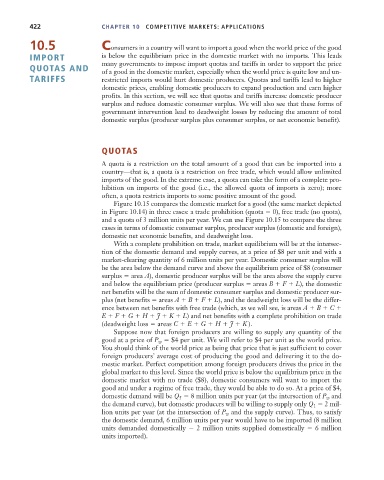Page 448 - Microeconomics, Fourth Edition
P. 448
c10competitive markets applications.qxd 7/15/10 4:58 PM Page 422
422 CHAPTER 10 COMPETITIVE MARKETS: APPLICATIONS
10.5 Consumers in a country will want to import a good when the world price of the good
IMPORT is below the equilibrium price in the domestic market with no imports. This leads
QUOTAS AND many governments to impose import quotas and tariffs in order to support the price
of a good in the domestic market, especially when the world price is quite low and un-
TARIFFS restricted imports would hurt domestic producers. Quotas and tariffs lead to higher
domestic prices, enabling domestic producers to expand production and earn higher
profits. In this section, we will see that quotas and tariffs increase domestic producer
surplus and reduce domestic consumer surplus. We will also see that these forms of
government intervention lead to deadweight losses by reducing the amount of total
domestic surplus (producer surplus plus consumer surplus, or net economic benefit).
QUOTAS
A quota is a restriction on the total amount of a good that can be imported into a
country—that is, a quota is a restriction on free trade, which would allow unlimited
imports of the good. In the extreme case, a quota can take the form of a complete pro-
hibition on imports of the good (i.e., the allowed quota of imports is zero); more
often, a quota restricts imports to some positive amount of the good.
Figure 10.15 compares the domestic market for a good (the same market depicted
in Figure 10.14) in three cases: a trade prohibition (quota 0), free trade (no quota),
and a quota of 3 million units per year. We can use Figure 10.15 to compare the three
cases in terms of domestic consumer surplus, producer surplus (domestic and foreign),
domestic net economic benefits, and deadweight loss.
With a complete prohibition on trade, market equilibrium will be at the intersec-
tion of the domestic demand and supply curves, at a price of $8 per unit and with a
market-clearing quantity of 6 million units per year. Domestic consumer surplus will
be the area below the demand curve and above the equilibrium price of $8 (consumer
surplus area A), domestic producer surplus will be the area above the supply curve
and below the equilibrium price (producer surplus areas B F L), the domestic
net benefits will be the sum of domestic consumer surplus and domestic producer sur-
plus (net benefits areas A B F L), and the deadweight loss will be the differ-
ence between net benefits with free trade (which, as we will see, is areas A B C
E F G H J K L) and net benefits with a complete prohibition on trade
(deadweight loss areas C E G H J K ).
Suppose now that foreign producers are willing to supply any quantity of the
good at a price of P $4 per unit. We will refer to $4 per unit as the world price.
w
You should think of the world price as being that price that is just sufficient to cover
foreign producers’ average cost of producing the good and delivering it to the do-
mestic market. Perfect competition among foreign producers drives the price in the
global market to this level. Since the world price is below the equilibrium price in the
domestic market with no trade ($8), domestic consumers will want to import the
good and under a regime of free trade, they would be able to do so. At a price of $4,
domestic demand will be Q 8 million units per year (at the intersection of P and
5
w
the demand curve), but domestic producers will be willing to supply only Q 2 mil-
1
lion units per year (at the intersection of P and the supply curve). Thus, to satisfy
w
the domestic demand, 6 million units per year would have to be imported (8 million
units demanded domestically 2 million units supplied domestically 6 million
units imported).

